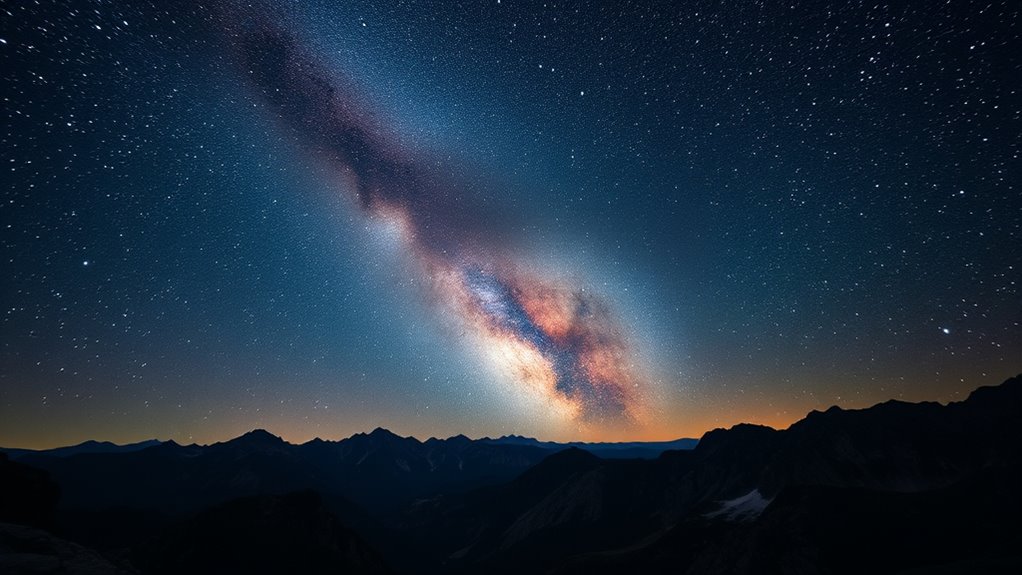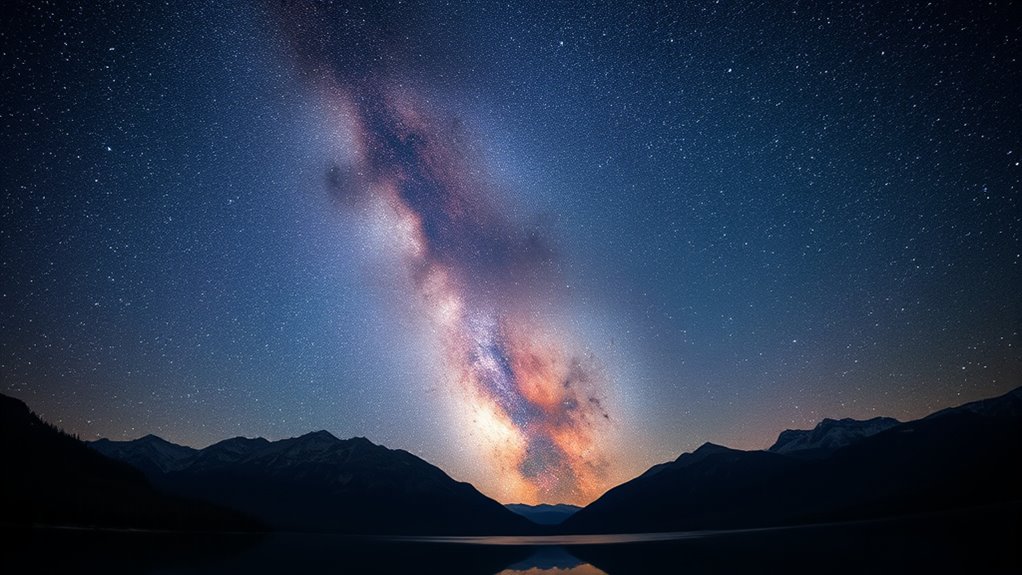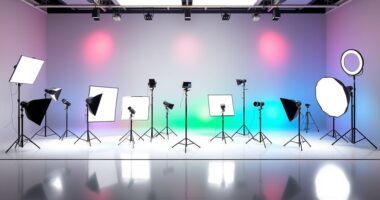If you’re aiming for stunning Milky Way shots in 2025, I recommend these four wide-field lenses: the Sony E 16mm F2.8 for its compact size and sharpness, the AstrHori 6mm F2.8 fisheye for dramatic circular shots, the VILTROX 75mm f/1.2 XF PRO for incredible low-light performance, and the VILTROX 75mm f/1.2 PRO E for versatile astrophotography. Each offers a great balance of wide coverage, bright aperture, and quality. Keep exploring to find out which lens suits your style best.
Key Takeaways
- Prioritize wide-angle lenses (14mm–24mm) with large apertures (f/2.8 or wider) for maximum light capture of the Milky Way.
- Opt for lenses with high optical quality, minimal distortion, and coatings that reduce flare and chromatic aberration.
- Choose compact, lightweight lenses for easier transport and quick setup during spontaneous night sky shoots.
- Manual focus capability is essential for precise focus on distant stars, while autofocus offers convenience in certain scenarios.
- Consider durability and compatibility with your camera mount to ensure reliable performance during outdoor astrophotography sessions.
Sony E 16mm F2.8 Wide-Angle Prime Lens
Are you looking for a compact lens that lets you capture stunning wide-angle shots of the Milky Way without adding bulk to your gear? The Sony E 16mm F2.8 is perfect for that. Its pancake design measures just 22.5mm and weighs only 67 grams, making it incredibly portable. Despite its size, it delivers sharp images with minimal distortion thanks to advanced optics. The bright F2.8 aperture allows plenty of light for night sky photography, and the responsive autofocus is quiet and smooth. Plus, compatibility with optional conversion lenses offers even more creative possibilities. It’s an ideal travel companion for capturing breathtaking astrophotos on the go.
Best For: photographers seeking a compact, lightweight wide-angle lens ideal for landscape, street, interior, and astrophotography on APS-C E-mount cameras.
Pros:
- Ultra-portable pancake design weighing only 67g, perfect for travel and spontaneous shots
- Sharp image quality with minimal distortion and spherical aberration due to advanced optical elements
- Bright F2.8 aperture and responsive autofocus suitable for night sky and video shooting
Cons:
- Fixed focal length limits versatility compared to zoom lenses
- No image stabilization, which may impact handheld low-light shooting
- Slightly limited minimum focus distance of 0.24 meters may restrict close-up macro opportunities
AstrHori 6mm F2.8 Circular Fisheye Lens for Nikon Z Mount
The AstrHori 6mm F2.8 Circular Fisheye Lens for Nikon Z Mount is an excellent choice for photographers aiming to capture the expansive beauty of the night sky, especially the Milky Way. Its 220° ultra-wide field of view surpasses human vision, creating immersive, striking visuals with a true circular fisheye effect. The large F2.8 aperture guarantees sharp images even in low light, making it perfect for astrophotography and night scenes. Built with a durable all-metal body, it’s compact and travel-ready. Ideal for creative landscapes, cityscapes, and VR content, this lens offers unmatched artistic flexibility for your Milky Way captures.
Best For: photographers and videographers passionate about astrophotography, nightscape, and creative wide-angle shots seeking a compact, durable fisheye lens for Nikon Z mount cameras.
Pros:
- Ultra-wide 220° field of view creates immersive and striking circular images.
- Large F2.8 aperture excels in low-light conditions, perfect for night sky photography.
- All-metal construction offers durability and a sleek, portable design.
Cons:
- Manual focus operation may require additional adjustments for precise results.
- Fixed focal length limits versatility compared to zoom lenses.
- Slight edge distortion is inherent to fisheye effects and may not suit all styles.
VILTROX 75mm f/1.2 XF PRO APS-C Lens for Fuji X-Mount Cameras
Photographers seeking exceptional low-light performance and beautiful bokeh will find the VILTROX 75mm f/1.2 XF PRO APS-C lens a perfect match. Its large f/1.2 aperture captures more light, making it ideal for Milky Way shots and portraits. Compatible with Fuji X-mount cameras like the X-T5 and X-H2, it features 16 lens elements, including high-refractive index glass, ensuring sharp, detailed images. The fast, quiet autofocus with manual override and eye focus support offers flexibility for both stills and video. Its durable design and electronic aperture make it a reliable tool for capturing stunning night skies in any conditions.
Best For: photographers and videographers who need excellent low-light performance, beautiful bokeh, and versatile autofocus capabilities with Fuji X-mount cameras.
Pros:
- Large f/1.2 aperture allows ample light capture for low-light conditions and stunning background blur.
- Advanced autofocus with eye focus support and quiet operation ideal for both photography and videography.
- Durable construction with electronic aperture and compatibility with USB upgrades ensures longevity and adaptability.
Cons:
- The 75mm focal length may be less versatile for wider scenes or street photography.
- Potentially higher price point due to premium optical design and features.
- Slightly larger and heavier compared to standard prime lenses, which could affect portability.
VILTROX 75mm f/1.2 PRO E Lens for Sony APS-C Cameras
If you’re looking to capture stunning images of the Milky Way with exceptional clarity, the VILTROX 75mm f/1.2 PRO E Lens is a top choice for Sony APS-C cameras. Its large f/1.2 aperture lets in maximum light, perfect for low-light astrophotography. With 16 elements in 11 groups, including high-refractive lenses, it delivers sharp, detailed images even at wide-open settings. The fast STM autofocus ensures quick, accurate focus, while the manual/auto switch adds versatility. Designed for Sony E-mount models like the a7 series and ZV-E lines, this lens combines optical excellence and low-light performance to elevate your Milky Way shots.
Best For: photographers and videographers seeking high-quality, low-light capable portrait, macro, or astrophotography images with Sony APS-C mirrorless cameras.
Pros:
- Large f/1.2 aperture provides excellent low-light performance and beautiful background blur
- Sharp, detailed images even at maximum aperture thanks to advanced optical design with 16 elements in 11 groups
- Fast, precise autofocus with support for eye, face, and animal modes, ideal for dynamic shooting scenarios
Cons:
- Heavier and bulkier compared to standard 75mm lenses due to extensive optical elements
- Higher price point reflecting premium build and optical quality
- Limited to Sony E-mount APS-C cameras, restricting compatibility with other systems
Factors to Consider When Choosing Wide-Field Lenses for Milky Way Photography

When selecting a wide-field lens for Milky Way photography, I consider factors like aperture size, focal length, and low-light performance to guarantee sharp, bright images. I also think about portability and how much distortion might affect my shots, especially in wide angles. These elements help me choose a lens that’s both practical and capable of capturing stunning night sky photos.
Aperture Size Importance
Choosing a wide-field lens with a large aperture is vital for successful Milky Way photography because it directly affects how much light reaches your camera sensor. A bigger aperture (smaller f-number, like f/2.8 or wider) allows more light to enter, which is essential for capturing faint stars and intricate Milky Way details in low-light conditions. It also reduces the need for long exposures, helping prevent star trails caused by Earth’s rotation. Plus, a large aperture improves your ability to shoot in darker environments without raising ISO, which keeps noise levels low. Keep in mind, wider apertures also create a shallower depth of field, making stars and celestial objects stand out sharply against the night sky. This makes aperture size a key factor in selecting your ideal lens.
Focal Length Selection
Selecting the right focal length for your wide-field lens is essential because it shapes how much of the night sky and landscape you’ll capture in your Milky Way shots. A focal length of 14mm to 24mm is ideal for dramatic, expansive views. Shorter focal lengths, like 14mm, provide broader sky coverage but may introduce distortion near the edges, which can be distracting. Longer focal lengths, above 20mm, allow for more zoomed-in images, making it easier to capture detailed sections of the Milky Way. Your choice depends on your desired composition, available space, and how much foreground you want to include. Wider lenses emphasize landscape context, while narrower ones focus more on the stars. Consider these factors carefully to achieve the perfect shot.
Low-Light Performance
The ability of a wide-field lens to perform well in low-light conditions substantially impacts the quality of Milky Way photos. A large maximum aperture, like f/2.8 or wider, allows more light onto the sensor, making it easier to capture faint stars and the galaxy itself. High optical quality and minimal chromatic aberration ensure sharpness and contrast in dark environments. Being able to focus at close distances can enhance foreground details, but the lens must also operate effectively at infinity focus for distant stars. A wide-angle focal length (around 14-24mm on crop sensors) offers a broad sky view, increasing your chances of capturing the Milky Way in one shot. Coatings that reduce flare and ghosting further improve low-light performance, ensuring clearer, more vibrant images.
Portability and Size
When heading out for Milky Way photography, the size and weight of your lens can make a big difference in how smoothly your night shoots go. Compact, lightweight lenses are ideal because they’re easier to carry and set up, especially in remote locations. Smaller lenses reduce the overall backpack weight, which is vital during long outdoor sessions. Ultra-wide lenses like 6mm fisheyes or 16mm primes are designed to be travel-friendly, letting you explore more without the bulk. Portability also allows for quick adjustments and setups, saving you time in challenging conditions. Plus, a lightweight lens helps prevent fatigue during extended shoots, making your experience more enjoyable. Choosing a smaller, portable lens ensures you’re ready for spontaneous shots and long nights under the stars.
Image Distortion Control
To capture the true beauty of the Milky Way, controlling image distortion is essential since even slight warping can misrepresent celestial details. Wide-field lenses with minimal barrel distortion help preserve the natural shapes of stars and the night sky. Lenses featuring aspherical elements reduce spherical aberrations, resulting in clearer, sharper star images. Correcting for edge distortion is also imperative to maintain the authentic appearance of celestial and landscape elements across the entire frame. A lens with a flat field focus prevents curvature that can warp the view of the Milky Way, especially near the edges. Additionally, optical designs that minimize chromatic aberration produce sharper images with true-to-life colors, ensuring your astrophotography captures the sky’s stunning details accurately.
Autofocus Speed
While controlling image distortion is essential for sharp, true-to-life Milky Way photos, autofocus speed is generally less important since manual focus often yields better results in low-light conditions. Autofocus speed can be helpful if you’re capturing fleeting moments or need to quickly switch focus between foreground and sky. However, many astrophotography lenses prioritize manual focus, offering greater precision and reliability in darkness. Fast autofocus systems may struggle to lock onto stars or distant objects, causing delays or missed shots. In low-light or night conditions, autofocus may hunt or fail entirely. That’s why most serious astrophotographers prefer manual focus techniques for the best control and consistency. Autofocus speed, while a bonus in some situations, isn’t a top priority for Milky Way photography.
Compatibility With Gear
Choosing a wide-field lens for Milky Way photography requires verifying it’s compatible with your camera’s mount and sensor size. Confirm the lens fits your camera, whether it’s Sony E-mount, Nikon Z, or another system. The focal length should be between 14mm and 24mm for ideal wide-angle shots. Make sure the lens supports manual focus, which gives you better control during low-light conditions. A maximum aperture of f/2.8 or wider is perfect to gather enough light for clear night sky images. Also, consider the lens’s size and weight to verify portability for on-location shoots. Compatibility isn’t just about fitting your camera; it’s about matching the lens’s features to your specific needs to achieve sharp, bright Milky Way photos without unnecessary hassle.
Frequently Asked Questions
Which Wide-Field Lens Offers the Best Balance of Image Quality and Affordability?
I believe the Canon RF 15-35mm f/2.8L IS USM offers the best balance of quality and affordability. Its wide focal range and fast aperture let you capture stunning night skies with sharp detail. Plus, it’s reasonably priced compared to other high-end lenses. I’ve used it myself, and its image quality is impressive without breaking the bank. For anyone wanting great Milky Way shots on a budget, this lens is a solid choice.
How Does Lens Distortion Affect Milky Way Astrophotography?
Think of lens distortion like a funhouse mirror—initially playful, but in astrophotography, it can distort the Milky Way’s beauty. It causes stars to appear stretched or warped, especially near the edges, reducing clarity. To capture the galaxy’s true splendor, I avoid heavy distortion by choosing lenses with minimal aberration and shooting centrally. This way, I preserve the cosmic landscape’s integrity and create stunning, accurate astrophotos.
Are Manual Focus Lenses Better Suited for Night Sky Photography?
Absolutely, I find manual focus lenses often better suited for night sky photography. They give me precise control over focus, which is vital in low-light conditions where autofocus can struggle. With manual focus, I can fine-tune the sharpness on distant stars or the Milky Way itself, ensuring my shots are crisp. It might take a little practice, but the results are worth it for those stunning, detailed astrophotos.
What Is the Optimal Aperture for Capturing the Milky Way?
I find that an aperture of f/2.8 or wider is ideal for capturing the Milky Way. It lets in enough light to reveal the stars and galactic details without excessive noise. If your lens opens wider, like f/1.4 or f/1.8, even better, but f/2.8 is a great balance for most situations. Remember, a wider aperture helps you shoot at shorter exposures, reducing star trails and capturing more stunning detail.
Can Wide-Angle Lenses Be Used Effectively With Star Trackers?
Absolutely, wide-angle lenses work wonders with star trackers! I’ve seen my shots transform into breathtaking cosmic panoramas using this combo. The wide field of view complements the star tracker’s ability to follow celestial objects smoothly, allowing longer exposures without star trails. Just make sure your lens has a fast aperture and is well-mounted. With patience, you’ll capture stunning, sharp images of the night sky that feel almost otherworldly.
Conclusion
Choosing the right wide-field lens is like picking the perfect brush for a masterpiece—each one helps you capture the night sky’s magic in a unique way. Whether you prefer the sweeping view of a 16mm or the intimate detail of a 75mm, your lens choice shapes your Milky Way photos. So, trust your instincts, pick the one that feels right, and get ready to paint stunning starry landscapes that will leave everyone in awe.















